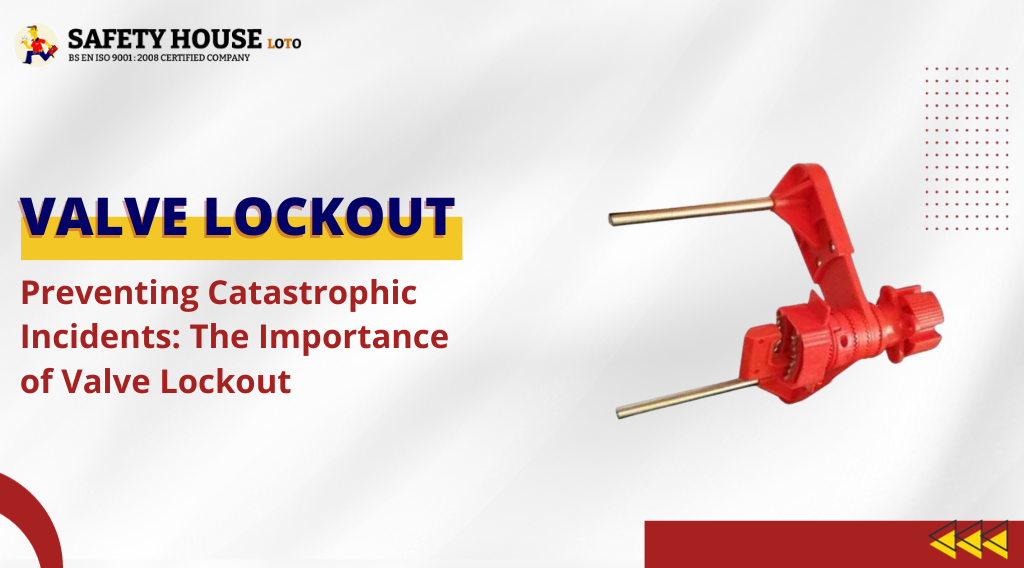
Preventing Catastrophic Incidents: The Importance of Valve Lockout
In the intricate dance of industry, where towering machines hum and energy pulses through a labyrinth of pipes, safety waltzes as the lead partner. One misstep, one errant movement, and the harmony erupts into a cacophony of chaos. In this intricate ballet, valves play a crucial role, controlling the flow of vital fluids – liquids and gases that can power cities, fuel production, or, if uncontrolled, unleash devastation. This is where valve lockout steps in, a vital safety measure that can prevent catastrophic incidents before they become headlines.
The Grim Reality: Why Valve Lockout Matters
Industrial accidents involving uncontrolled valve operations are not mere statistics; they are grim reminders of the potential consequences of complacency. From fiery explosions at chemical plants to toxic gas leaks causing mass evacuations, the dangers are real and often fatal. In 2013, a ruptured pipeline in West Virginia sparked a gas explosion that leveled homes and claimed nine lives. In 2019, a faulty valve at a fertilizer plant in Iowa triggered a deadly explosion, wiping out entire buildings and injuring dozens. These tragedies highlight the urgency of robust safety protocols, where valve lockout stands as a sentinel against such incidents.
Understanding Valve Lockout: More than Just a Padlock
Valve lockout goes beyond simply adding a padlock to a valve handle. It’s a comprehensive safety program that involves identifying and isolating energy sources, applying appropriate lockout devices, and verifying their effectiveness. This not only ensures that valves remain in their desired positions during maintenance or repair activities but also prevents accidental activation, protecting both personnel and equipment.
Valve lockout isn’t just a safety measure; it’s a treasure trove of benefits that trickle down to every corner of your industrial operation. It’s like planting a safety seed that blossoms into a bountiful harvest of:
A Feast of Benefits for Every Industry: Valve Lockout
- Enhanced Worker Safety: This is the crown jewel of the valve lockout kingdom. It minimizes the risk of accidental valve operation, protecting your workforce from hazardous energy releases, toxic leaks, and fiery explosions. No more sleepless nights worrying about your team’s well-being!
- Reduced Downtime and Increased Productivity: Say goodbye to scrambling after accidental valve openings that halt production. Valve lockout ensures planned and controlled maintenance, minimizing downtime and keeping your machines humming like a well-oiled symphony. More uptime means more output, more satisfied customers, and bigger smiles all around.
- Boosted Compliance and Lowered Costs: Dodging hefty fines from regulatory bodies is a sweet perk. Valve lockout adherence ensures compliance with safety regulations, saving you the financial sting of non-compliance and potential lawsuits. Think of it as an investment in peace of mind and a lighter wallet.
- Improved Equipment Lifespan: Uncontrolled valve operation is like throwing your equipment into a gladiator arena. Valve lockout shields your machinery from unnecessary wear and tear, extending its lifespan and saving you costly replacements. It’s like gifting your equipment a rejuvenating spa day, keeping it young and vibrant for years to come.
The Valve Lockout Arsenal: Tools for Every Situation
Valve lockout manufacturer in Delhi, and across the globe, offer a diverse range of devices to cater to different valve types and operational needs. These include:
- Ball valve lockouts: Designed for securing ball valves, with options for various handle sizes and locking mechanisms.
- Gate valve lockouts: These robust devices fit onto the valve handles and prevent unauthorized opening or closing.
- Butterfly valve lockouts: Specially designed for butterfly valves, they effectively immobilize the handle.
- Lockout hasps and tags: These versatile tools allow multiple padlocks to be used on a single valve and provide clear identification of lockout procedures.
Choosing the right valve lockout manufacturer in Delhi requires careful consideration of your specific industry, valve types, and safety protocols. Look for manufacturers with a proven track record, certifications, and adherence to international safety standards.
Beyond Tools: Embedding Valve Lockout in Your Safety Culture
While the right tools are essential, valve lockout’s true effectiveness lies in integrating into your safety culture. This involves:
- Training: Thoroughly train all personnel on lockout procedures, identifying different valve types and the appropriate devices.
- Audits and inspections: Regularly conduct audits to ensure compliance with lockout protocols and identify potential hazards.
- Emergency preparedness: Integrate valve lockout procedures into emergency response plans and drills.
By fostering a culture of safety and vigilance, valve lockout transforms from a mere procedure into a powerful shield against preventable incidents.
Valve Lockout: An Investment in Safety, a Guarantee for Progress
Investing in valve lockout is not an expense; it’s an investment in safety, in human lives, and in the continued smooth operation of your enterprise. It’s a guarantee that the intricate dance of industry can continue uninterrupted, free from the discordant notes of catastrophe. So, make valve lockout a cornerstone of your safety culture, choose the right valve lockout manufacturer in Delhi or your region, and ensure that progress flows unimpeded, guided by the steady rhythm of safety.
Remember: Valve lockout is not a one-time fix; it’s a continuous commitment to safety. By prioritizing valve lockout and nurturing a safety-conscious culture, you can prevent incidents, protect lives, and ensure that your organization hums to the tune of success, without ever risking a catastrophic finale.
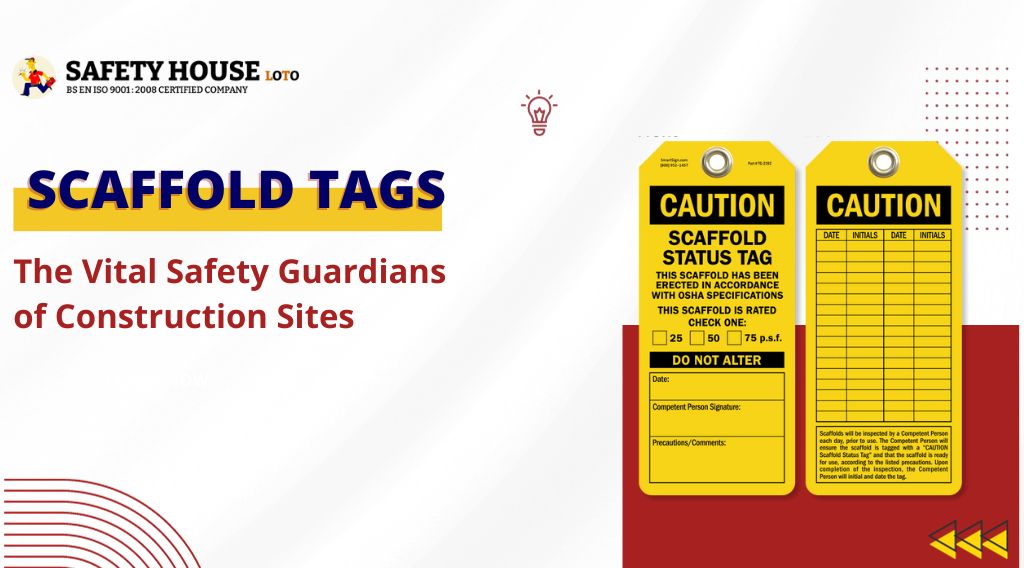
Scaffold Tags: The Vital Safety Guardians of Construction Sites
Construction sites are bustling hubs of activity, but amidst the controlled chaos, safety remains paramount. Workers navigate a complex landscape of materials, equipment, and potential hazards, and every step must be taken to ensure their well-being. In this intricate safety ecosystem, scaffold tags play a crucial role, silently standing guard as vital safety guardians.
What are Scaffold Tags?
Scaffold tags are small, yet potent safety devices attached to scaffolding components. They serve as visual indicators, communicating crucial information about the scaffold’s load capacity, weight limitations, and inspection status. Typically made of durable materials like weatherproof plastic or metal, scaffold tags come in various colors and designs to easily convey specific messages.
Why are Scaffold Tags Important?
The importance of tags cannot be overstated. They function as the first line of defense against potential accidents and injuries on construction sites. Here’s how they contribute to enhanced safety:
- Clear and concise communication: Scaffold tags provide instant visual information about the scaffold’s capabilities and limitations. This eliminates any ambiguity or confusion that could lead to misuse or overloading.
- Promotes adherence to safety regulations: Different tag colors and symbols correspond to specific safety standards and regulations. This ensures that workers are readily aware of the guidelines they need to follow while working on the scaffolding.
- Facilitates regular inspections: Scaffold tags often include spaces to record inspection dates and findings. This promotes a culture of regular maintenance and timely identification of potential hazards.
- Raises safety awareness: The constant presence of scaffold tags is a constant reminder of the importance of safety. This keeps workers vigilant and reinforces safe practices throughout the construction process.
Types of Scaffold Tags
Scaffold tags come in a variety of types, each serving a specific purpose. Some of the most common ones include:
- Load capacity tags specify the maximum weight the scaffold can safely support. Exceeding this limit can lead to catastrophic failure, hence the critical role of these tags.
- Inspection tags: These tags document the date of the last scaffold inspection and any things to note that were identified. Regular inspections are essential for maintaining the integrity of the scaffolding.
- Do not climb tags: These tags serve as a clear warning, prohibiting unauthorized from climbing on the scaffolding. This helps to prevent falls and other accidents.
- Out-of-order tags: These tags identify scaffolding components that are defective or unsafe for use. This prevents workers from inadvertently using damaged equipment and incurring risks.
Choosing the Right Safety Tags Manufacturer
With the safety of workers at stake, choosing the right scaffold tag manufacturer is crucial. Look for a manufacturer that:
- Uses high-quality materials: The tags should be durable and weatherproof to withstand harsh construction site conditions.
- Offers a variety of tags: The manufacturer should cater to diverse needs with a range of tags addressing different safety aspects.
- Complies with safety regulations: Ensure the tags comply with relevant safety standards and regulations in your region.
- Provides clear and easy-to-understand tags: The information on the tags should be unambiguous and readily understandable by workers.
Investing in Safety, Investing in Lives
Scaffold tags may seem like small,ordinity objects, but their impact on construction site safety is undeniable. By providing clear and concise information, they empower workers to make informed decisions and navigate the complexities of scaffolding with confidence. Remember, safety is not an expense; it’s an investment in the well-being of your workforce and the long-term success of your construction projects. So, prioritize scaffold tags as vital safety guardians, and watch your construction site transform into a haven of safety and productivity.
Additional Tips for Scaffold Safety
- Always follow manufacturer instructions for assembling and using scaffolding.
- Never overload a scaffold beyond its rated capacity.
- Inspect scaffolds regularly for damage or defects.
- Wear appropriate personal protective equipment (PPE) when working on or around scaffolding.
- Train workers on proper scaffold safety procedures.
By following these tips and making scaffold tags an integral part of your safety protocols, you can create a safer construction site for everyone involved.
I hope this blog post has been informative and insightful. If you have any questions or suggestions, please feel free to leave a comment below.

Streamlining Safety: The Role of Lockout Stations in Industrial Settings
In the dynamic realm of industrial operations, safety remains paramount, demanding a proactive approach to mitigate risks and protect workers. Lockout stations, often overlooked yet crucial components of a comprehensive safety strategy, play a pivotal role in ensuring the well-being of personnel by streamlining lockout procedures and fostering a culture of safety.
Understanding Lockout Stations: The Guardians of Safety
Lockout stations, also known as lockout/tagout (LOTO) stations, serve as central repositories for storing and organizing lockout devices, such as locks, tags, and hasps. These stations, strategically positioned throughout industrial facilities, provide easy access to the necessary tools for effectively isolating hazardous energy sources during maintenance or servicing tasks.
The Significance of Lockout Stations
The implementation of lockout stations offers a myriad of benefits that contribute to enhanced safety and streamlined operations:
- Organized Storage: Lockout stations eliminate the clutter of scattered lockout devices, ensuring that essential safety tools are readily available when needed. This organized approach eliminates time spent searching for equipment, expediting maintenance procedures and minimizing downtime.
- Standardized Procedures: Lockout stations promote standardization of LOTO procedures by providing a consistent location for storing and accessing lockout devices. This standardization ensures that workers across different departments and shifts follow uniform safety protocols, reducing the risk of human error.
- Visual Reminders: Lockout stations serve as visual reminders of the importance of LOTO procedures. Their presence reinforces safety awareness and encourages workers to adhere to established protocols, fostering a culture of caution and prevention.
- Accessibility: Strategically placed lockout stations ensure that workers have easy access to the necessary lockout devices, regardless of their location within the facility. This accessibility promotes prompt and effective isolation of hazardous energy sources.
- Inventory Control: Lockout stations provide a centralized location for tracking and managing lockout devices, preventing loss or misplacement. This inventory control mechanism ensures that the necessary equipment is always available when needed.
Lockout Stations: A Cornerstone of Safety Culture
The integration of lockout stations into a comprehensive safety strategy is essential for creating a safer work environment. By streamlining LOTO procedures and promoting a culture of safety, lockout stations contribute significantly to reducing workplace accidents and safeguarding the well-being of workers.
Essential Lockout Products for Industrial Settings
To ensure the effectiveness of lockout procedures, industrial facilities should equip themselves with a range of lockout products, including:
- Padlocks: Personal padlocks are crucial for securing energy-isolating devices, preventing unauthorized access, and ensuring that only authorized personnel can operate the equipment.
- Tags: Lockout tags provide clear, visible warnings that equipment is undergoing maintenance or servicing, preventing accidental operation.
- Hasps: Hasps are used to prevent the use of more than one lock on an energy-isolating device, ensuring that only the authorized worker can remove their lock.
- Lockout Stations: Lockout stations serve as central repositories for storing and organizing lockout devices, providing easy access and promoting standardized procedures.
Conclusion
Lockout stations, often unassuming yet essential components of industrial safety, play a pivotal role in safeguarding workers and preventing workplace accidents. By streamlining LOTO procedures, promoting a culture of safety, and providing easy access to essential lockout devices, lockout stations contribute significantly to a safer and more productive work environment.

Lockout Tags Compliance: A Vital Component of Workplace Safety
Unleashing the Power of Lockout Tags for a Safer Workplace
In the dynamic world of industrial operations, workplace safety remains paramount. Among the crucial aspects of ensuring safety, lockout tagout (LOTO) procedures stand out as a cornerstone of protection. LOTO procedures, often overlooked, play a pivotal role in safeguarding employees from the perils of hazardous energy sources.
Unveiling Lockout Tags: A Guardian Against Unforeseen Energy Release
Lockout tags are safety protocols designed to control and isolate hazardous energy sources during equipment maintenance, repair, or servicing. By effectively de-energizing machinery and equipment, LOTO procedures prevent the unexpected release of energy, which can lead to catastrophic consequences, including severe injuries, fatalities, and equipment damage.
The Regulatory Landscape: OSHA‘s Mandate for LOTO Compliance
The Occupational Safety and Health Administration (OSHA) recognizes the significance of LOTO in safeguarding workers. To enforce LOTO compliance, OSHA has established comprehensive regulations and standards, outlined in 29 CFR 1910.147. These regulations mandate employers to implement effective LOTO programs to protect workers from hazardous energy sources.
Unveiling the Anatomy of an Effective LOTO Program
A successful LOTO program comprises several essential components that work in unison to ensure worker safety and regulatory compliance. These components include:
- A Comprehensive LOTO Policy: A well-documented policy serves as the foundation of an effective LOTO program. It outlines the program’s objectives, responsibilities, and procedures, providing clear guidance for all employees.
- LOTO Training for Employees: Equipping employees with the knowledge and skills to implement LOTO procedures is crucial. Regular training ensures that employees understand the importance of LOTO and can effectively apply the procedures in various scenarios.
- Energy Source Identification and Isolation: Accurately identifying and isolating energy sources is fundamental to LOTO success. This involves conducting hazard assessments and developing detailed procedures for isolating each type of energy source.
- Lockout and Tagout Procedures: Implementing standardized lockout and tagout procedures is essential. These procedures specify the specific devices, such as padlocks and hasps, and warning tags to be used for each energy source.
- LOTO Procedure Testing and Validation: Regularly testing and validating LOTO procedures ensures their effectiveness in preventing the release of hazardous energy. This involves simulating real-world scenarios and verifying that procedures are properly followed.
- Continuous LOTO Program Audits: Periodic audits of the LOTO program are crucial for identifying and addressing any gaps or inconsistencies. This proactive approach helps maintain compliance and continuous improvement.
Harnessing the Power of Lockout Tags: Your Sentinels of Safety
Lockout tags are not merely physical objects; they are sentinels of safety, standing guard against inadvertent equipment operation during maintenance or servicing. These seemingly simple devices play a pivotal role in lockout/tagout (LOTO) procedures, serving as visible reminders and physical barriers that prevent unauthorized access to hazardous energy sources.
A Visual Declaration of Safety
When properly secured to energy-isolating devices, lockout tags immediately communicate a critical message: “This equipment is undergoing maintenance. Do not operate!” Their bold, unambiguous warnings serve as a stark visual cue, alerting workers and passersby to the potential hazard. This visual declaration of safety is particularly crucial in industrial environments where noise and distractions can hinder verbal communication.
A Physical Barrier Against Unintended Activation
Beyond their communicative role, lockout tags also function as physical barriers, preventing unauthorized access to energy sources. By securing the isolation valves, switches, or control points with personal locks and tags, authorized workers effectively safeguard the equipment from accidental energization. This physical restraint ensures that only those actively involved in the maintenance process can manipulate the equipment controls.
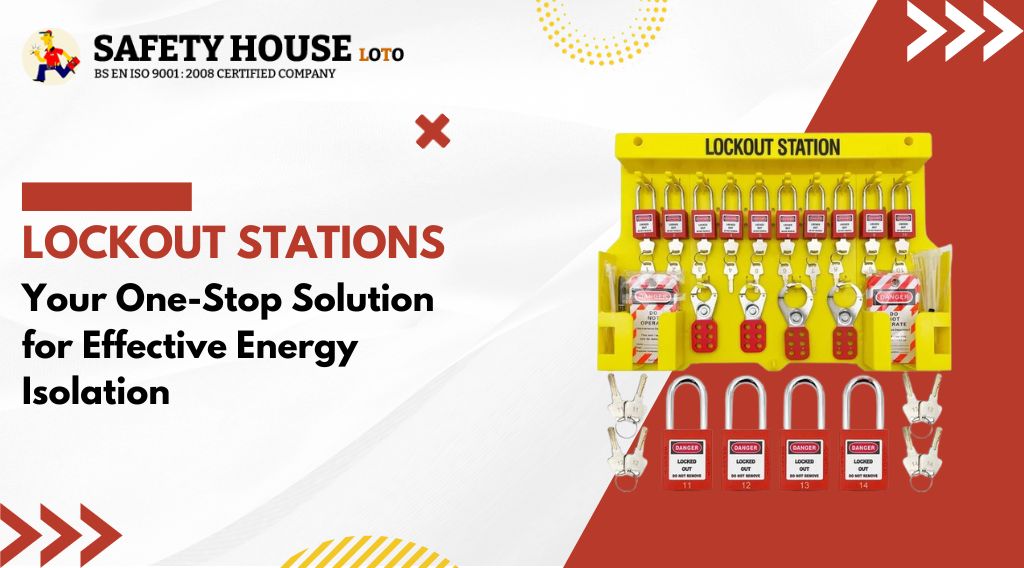
Lockout Stations: Your One-Stop Solution for Effective Energy Isolation
In the realm of workplace safety, the ability to effectively isolate energy sources is a critical component of accident prevention. Lockout stations, a key offering among lockout tagout products provided by reputable lockout suppliers, play a pivotal role in ensuring the safety of workers while enhancing the efficiency of energy isolation procedures. In this article, we will explore the significance of lockout stations, their benefits, and how they contribute to a safer and more organized work environment.
Lockout stations, often referred to as lockout centers or stations, are specialized organizational units designed to centralize and streamline the management of lockout tagout (LOTO) equipment. These stations provide a dedicated and easily accessible location for storing lockout devices, padlocks, hasps, lockout tags, and other essential LOTO tools and accessories. Their primary purpose is to facilitate the safe isolation of energy sources during maintenance, servicing, or repairs, and to ensure that the right equipment is readily available for employees.
The Significance of Lockout Stations
Lockout stations offer numerous advantages that significantly contribute to workplace safety and operational efficiency:
1. Enhanced Organization
One of the primary functions of a lockout station is to keep all LOTO equipment in one centralized location. This ensures that employees can quickly access the tools they need to safely isolate energy sources, reducing downtime and streamlining maintenance procedures.
2. Improved Visibility
Lockout stations are often designed with transparent covers or doors, allowing for easy visual assessment of the availability of lockout devices and equipment. This visibility makes it simple to see when tools are in use, ensuring that employees can work safely.
3. Accountability
Many lockout stations feature slots and compartments for lockout tags and labels. These tags provide essential information about ongoing maintenance or repair work, along with details about the responsible personnel. Accountability is crucial in ensuring that all workers are aware of the work in progress and the necessary safety measures.
4. Customization
Different facilities may have unique LOTO requirements based on their specific equipment and procedures. Lockout stations can be customized to accommodate these specific needs, including the number of lockout points and the types of energy sources to be isolated.
Utilizing Lockout Stations for Efficient Energy Isolation
Lockout stations serve as command centers for energy isolation. Here’s how they work to enhance safety and streamline operations:
- Identification: The lockout station provides a designated space for each type of lockout device. Employees can easily identify and select the appropriate equipment for their tasks.
- Accessibility: Lockout stations are typically strategically placed in areas where they are easily accessible to workers involved in maintenance activities. This proximity ensures that employees don’t need to search for individual lockout points or create makeshift arrangements.
- Visibility: The transparent covers or doors of lockout stations allow workers to see at a glance which devices are available, eliminating the need to search or inquire about tool availability.
- Accountability: Lockout stations often feature built-in slots for lockout tags or labels. These tags provide essential information about ongoing maintenance work and the responsible personnel, reinforcing a culture of accountability.
Conclusion
In a world where workplace safety and efficiency are of utmost importance, the role of lockout stations cannot be understated. They offer a centralized solution for managing LOTO equipment, promoting organization, accountability, and visibility. Lockout stations not only enhance safety but also contribute to smoother operations by ensuring that the right tools are readily available. Businesses that prioritize safety and efficiency turn to lockout stations as a testament to their commitment to a safer and more productive work environment.
For a comprehensive range of lockout stations and other lockout tagout products, explore offerings from your trusted Lockout Supplier today.
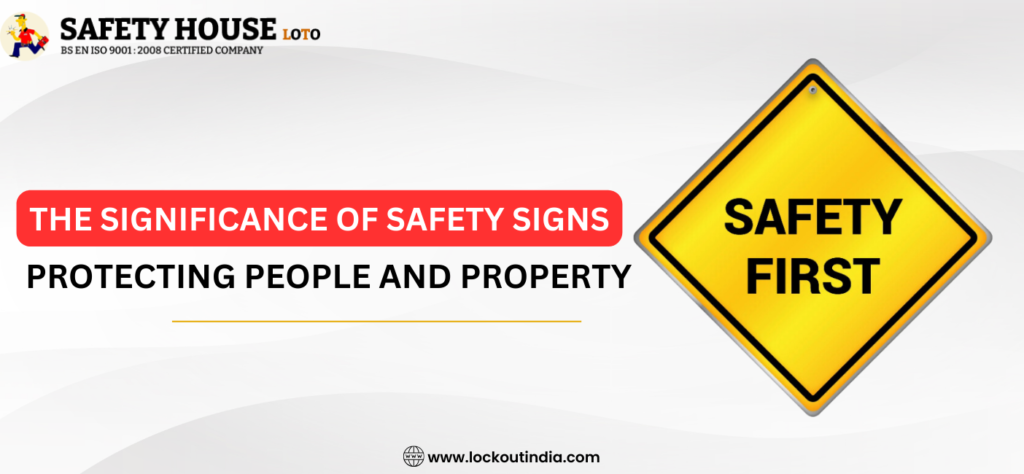
The Significance of Safety Signs: Protecting People and Property
In a world where safety is paramount, the role of safety signs cannot be overstated. These visual cues, often underestimated, are vital tools in safeguarding both people and property. Whether you’re navigating a construction site, working in a chemical plant, or simply walking down the hallway of a building, safety signs are an essential component of our daily lives. In this comprehensive article, we will delve into the significance of safety signs, their various types and applications, and how they contribute to a safer environment. We will also explore the role of a lockout supplier and lockout tags in enhancing safety protocols.
Understanding the Importance of Safety Signs
- Communication of Hazards: Safety signs are the unsung heroes of hazard communication. They provide crucial information about potential dangers in a specific area. These hazards can range from slippery floors to high-voltage electrical equipment. By alerting individuals to these risks, safety signs help prevent accidents and injuries.
- Guidance and Instructions: Safety signs don’t just warn; they also guide. Think of the signs that direct you to emergency exits or indicate the location of fire extinguishers. In emergency situations, these signs can be lifesavers, ensuring a swift and orderly evacuation.
- Legal Compliance: In many countries, there are strict regulations regarding safety signage. Failing to display the appropriate signs can result in legal consequences for businesses. Compliance with these regulations not only keeps you on the right side of the law but also underscores your commitment to safety.
Types of Safety Signs
Safety signs come in various forms, each with its own set of meanings and purposes. Here are some common types:
1. Prohibition Signs
These symbols indicate actions or behaviours that are not permitted. Examples contain “No Smoking,” “No Entry,” or “Do Not Touch.”
2. Warning Signs
Warning signs alert people to potential hazards. They often feature a distinctive yellow triangle with a black symbol. Examples include “Caution: Wet Floor” and “High Voltage.”
3. Mandatory Signs
Mandatory signs tell individuals what they must do. For instance, “Wear Safety Goggles” or “Keep Out” signs comes under this category.
4. Emergency Signs
Emergency signs provide directions during crises. They include “Exit” signs, which guide people to safety, and “Fire Extinguisher” signs, which show the location of firefighting equipment.
5. Safety Equipment Signs
These signs inform individuals about the availability and location of safety equipment. Examples incorporate “First Aid Kit Inside” and “Emergency Shower.”
6. Construction Signs
Construction sites use signs to warn about potential dangers such as falling objects, heavy equipment, or restricted access.
The Role of Lockout Supplier and Lockout Tags
In safety-critical environments, such as manufacturing plants, construction sites, or laboratories, the use of lockout/tagout (LOTO) procedures is essential to prevent accidents during equipment maintenance. A reliable lockout supplier plays a crucial role in providing the necessary tools and equipment for LOTO procedures, including lockout tags. Here’s how they contribute to safety:
- Quality Lockout Devices: A reputable lockout supplier offers high-quality lockout devices that are essential for isolating energy sources and ensuring the safety of maintenance personnel. These devices are designed to withstand harsh industrial conditions and prevent accidental equipment start-ups.
- Customization Options: Different facilities have unique lockout requirements. A trusted lockout supplier provides customization options, allowing businesses to tailor their lockout solutions to specific equipment and procedures. This ensures that the lockout process is efficient and effective.
- Comprehensive Lockout Kits: Lockout suppliers often offer comprehensive lockout kits that include a variety of devices, including lockout tags. These kits simplify the implementation of LOTO procedures by providing all the necessary tools in one package.
- Lockout Tags and Labels: Lockout tags are a crucial part of the LOTO process. They provide information about the maintenance or repair work being conducted, as well as the responsible personnel. Lockout tags help prevent accidental re-energization of equipment and ensure the safety of workers.
Conclusion
Safety signs are silent guardians, communicating hazards and guiding us to safety every day. They are a fundamental part of any safety program, protecting both people and property. Additionally, the role of a lockout supplier and lockout tags in enhancing safety cannot be understated. Together, these elements form a comprehensive safety strategy that safeguards lives and prevents accidents in workplaces across various industries. In a world where safety is paramount, the significance of safety signs, lockout suppliers, and lockout tags cannot be overstated.
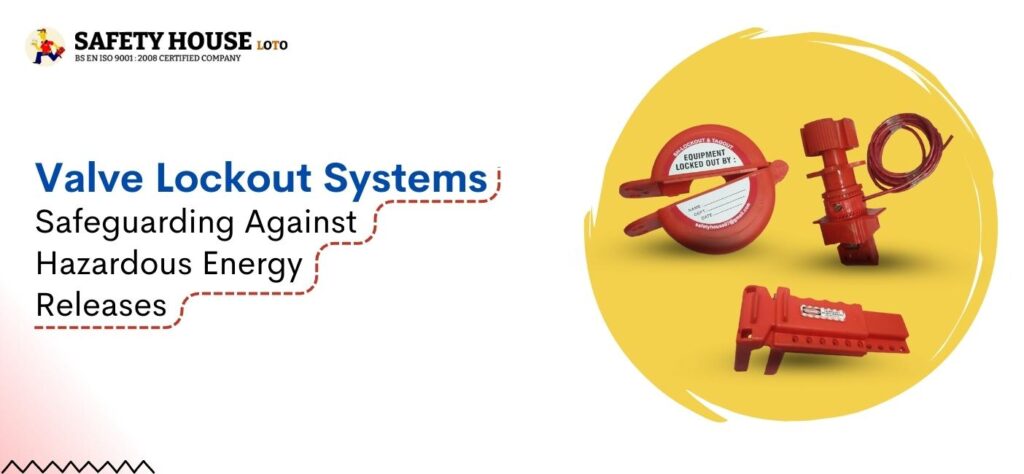
Valve Lockout Systems: Safeguarding Against Hazardous Energy Releases
In industrial settings, safety is paramount, especially when dealing with potentially hazardous energy sources. Valve lockout systems are indispensable safety lockout products designed to prevent unintended release of energy, securing the well-being of workers and minimizing the risk of accidents. In this article, we’ll explore the significance of valve lockout systems, their benefits, and how they contribute to a safer work environment.
The Role of Valve Lockout Systems in Safety
Valve lockout systems are engineered to isolate valves, preventing their operation during maintenance, repairs, or servicing. They are an essential component of any comprehensive safety lockout program and play a crucial role in safeguarding workers against unexpected energy releases. These systems are particularly effective in environments where various energy sources are present.
Understanding Valve Lockout
Valve lockout systems typically consist of lockout devices that fit over valve handles, preventing them from being turned or operated. These devices are often accompanied by lockout tags and labels, providing clear indications that the valve is locked out for maintenance. By immobilizing valves, these systems reduce the risk of hazardous substances, such as steam, gas, or chemicals, escaping and causing potential harm.
Benefits of Valve Lockout Systems
- Enhanced Worker Safety: Valve lockout systems provide a physical barrier that inhibits unauthorized or accidental valve operation. This minimizes the chances of workers being exposed to dangerous energy releases, contributing to a safer working environment.
- Compliance with Regulations: Implementing valve lockout systems is not only a best practice but also a legal requirement in many industries. Organizations that adhere to safety regulations, such as those outlined by OSHA, showcase their commitment to employee welfare and can avoid costly penalties.
- Versatility in Application: Valve lockout systems can be adapted for various types of valves, including ball valves, gate valves, and butterfly valves. This versatility ensures that different valve systems can be effectively locked out, regardless of their design or function.
How Valve Lockout Systems Work?
- Identification: Identify the valve to be locked out and its energy source.
- Selection: Choose the appropriate valve lockout device based on the valve type and size.
- Application: Attach the lockout device over the valve handle, immobilizing it in the off or closed position.
- Securing: Apply a lockout padlock to the device, ensuring the valve remains in the locked-out state.
- Tagging: Attach a lockout tag indicating the reason for the lockout and the responsible personnel.
Conclusion
Valve lockout systems are pivotal in maintaining a secure working environment, preventing hazardous energy releases that could lead to accidents or injuries. By implementing these safety lockout products, organizations prioritize worker safety, adhere to regulations, and create a culture of responsible energy control. Valve lockout systems stand as a testament to the commitment to safety and employee well-being in any industrial setting.
Remember, investing in quality valve lockout systems and ensuring proper training for employees on their usage is essential for the overall success of your safety lockout program.
Checkout Our Other Products:
- Loto Kit
- Lockout hasp
- Valve lockout
- Lockout station
- Lockout station
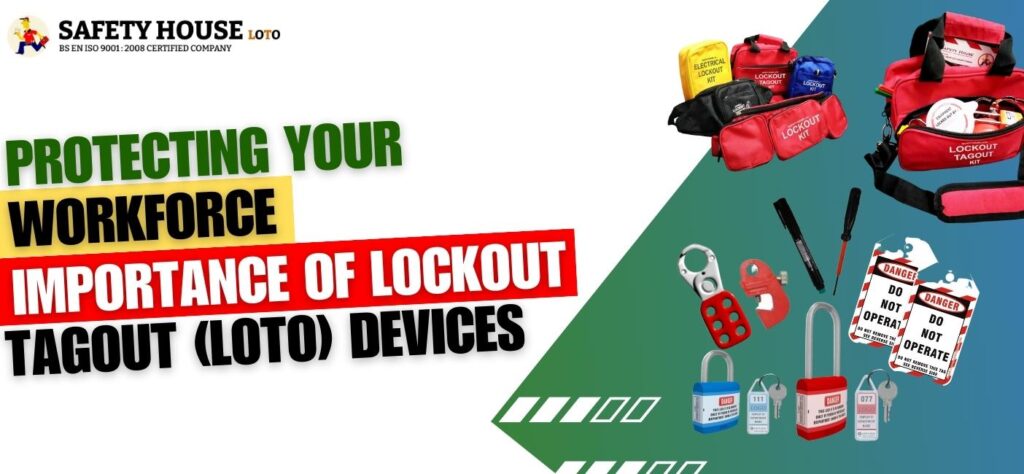
Protecting Your Workforce: The Importance of Lockout Tagout (LOTO) Devices
Introduction
Ensuring the safety of your workforce should always be a top priority in any industry. One critical aspect of workplace safety is the proper implementation of lockout tagout (LOTO) devices. These devices play a crucial role in safeguarding employees from hazardous energy sources during maintenance and repair activities. In this article, we will delve into the importance of lockout tagout devices, their benefits, and how they contribute to a safer work environment.
Lockout tagout devices are specifically designed to prevent accidental energization of machinery or equipment during servicing or maintenance operations. These devices provide a visual indication and physical barrier to ensure that equipment remains in a de-energized state, protecting workers from potentially life-threatening situations. By effectively isolating energy sources, lockout tagout devices help reduce the risk of injuries caused by unexpected equipment start-ups.
The Benefits of Lockout Tagout Devices
1. Enhanced Employee Safety
The primary benefit of utilizing lockout tagout devices is the increased safety they provide for employees. By effectively isolating energy sources, these devices create a clear and visible indication that equipment is undergoing maintenance or repair, alerting employees to potential hazards. This minimizes the risk of accidental injuries caused by the sudden release of stored energy or unexpected activation of machinery.
2. Compliance with Safety Regulations
Adhering to safety regulations is not only ethically important but also legally mandated. Lockout tagout devices help companies comply with regulations set forth by organizations such as the Occupational Safety and Health Administration (OSHA) and other regulatory bodies. Failure to comply with these rules may result in severe sanctions and legal consequences. Implementing lockout tagout products demonstrates a commitment to employee safety and ensures compliance with industry standards.
Choosing the Right Lockout Tagout Manufacturer
1. Quality and Reliability
When it comes to lockout tagout devices, selecting a reputable and reliable manufacturer is crucial. A trusted manufacturer of lockout products will ensure that their devices are built to withstand harsh environments, provide clear and durable labels, and offer long-lasting performance. Investing in quality lockout tagout products enhances the effectiveness of your safety protocols and contributes to a safer work environment.
2. Customization and Compatibility
Every workplace has unique requirements, and lockout tagout devices should be tailored to meet those specific needs. A reliable lockout tagout manufacturer will offer customization options to accommodate various equipment types and energy sources. Additionally, compatibility with existing lockout tagout procedures and systems is essential to maintain consistency and efficiency in your safety protocols.
Conclusion
Protecting your workforce is a vital responsibility for any organization, and lockout tagout devices are indispensable tools for ensuring employee safety during maintenance and repair operations. By understanding the importance of lockout tagout devices, their benefits, and the significance of selecting a reputable manufacturer, you can create a safer work environment and reduce the risk of accidents. Prioritize the implementation of lockout tagout devices, comply with safety regulations, and provide your employees with the highest level of protection.
By incorporating lockout tagout devices into your safety procedures, you demonstrate a commitment to the well-being of your workforce, foster a culture of safety, and contribute to a more productive and accident-free workplace environment.
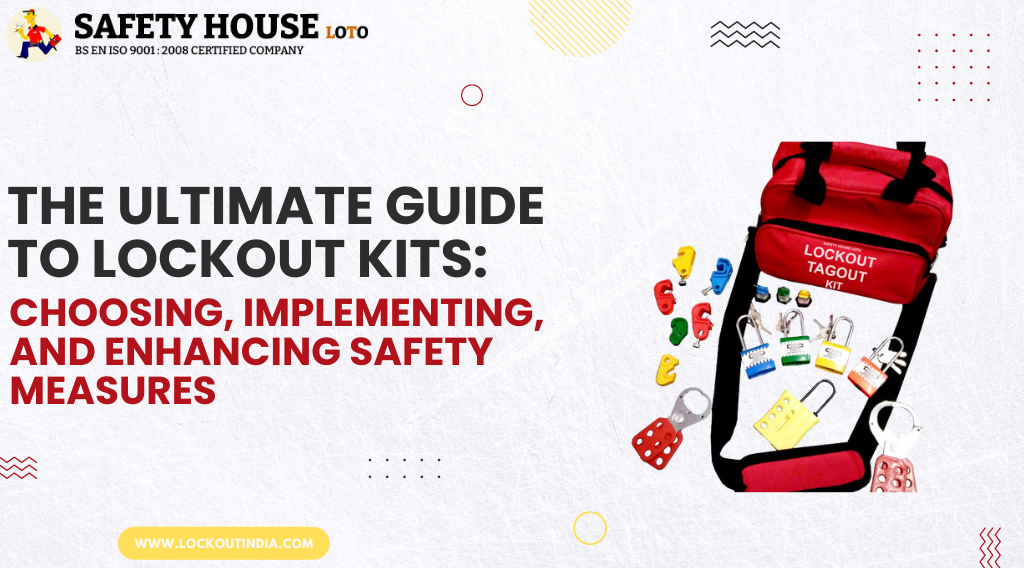
The Ultimate Guide to Lockout Kits: Choosing, Implementing, and Enhancing Safety Measures
Lockout kits, also known as LOTO kits, are an essential component of workplace safety. These kits provide workers with the necessary tools and equipment to isolate machinery or equipment from its energy source during maintenance or repair work. Failure to implement proper lockout procedures can result in serious injuries or even fatal accidents. In this ultimate guide, we’ll explore the different types of lockout kits available on the market today and discuss what you need to look for when choosing one for your business. We’ll also cover how to implement a lockout kit effectively and enhance overall safety measures in your workplace. So let’s dive in!
What Is A Lockout Kit?
A lockout kit, also known as a LOTO kit, is a collection of tools and equipment designed to help workers isolate machinery or equipment from its energy source. Lockout kits typically consist of padlocks, hasps, tags, circuit breakers, and other safety devices that prevent the accidental release of hazardous energy.
When using a lockout kit, workers are required to follow specific procedures before performing maintenance or repair work on the equipment. These procedures involve isolating the energy source and ensuring that it cannot be re-energized until work is completed.
Lockout kits can come in various sizes and configurations depending on the type of machinery or equipment being serviced. Some kits may include specialized devices such as valve lockouts or electrical disconnects for specific applications.
Implementing proper lockout/tag-out procedures with a lockout kit helps ensure worker safety by preventing accidents caused by unexpected energization during servicing activities.
The Different Types Of Lockout Kits
Lockout kits come in various forms to cater to different industries and applications. The types of lockout kits that are available include electrical, mechanical, pneumatic, hydraulic, and combination lockout kits.
Electrical lockout kits are designed to prevent the accidental or unauthorized operation of electrical equipment during maintenance or repair work.
Mechanical lockout kits contain devices such as lockout padlocks and loto hasps which can be used to secure machinery with moving parts.
Pneumatic lockout kits prevent compressed air from being released accidentally during servicing procedures on pneumatically operated machines.
Hydraulic lockout kits similarly protect against any hydraulic energy that could potentially harm workers when working on hydraulic-powered systems.
Combination lockout kits may include a mix of devices from each category depending on the specific needs of a workplace.
When choosing a type of kit, it is important to ensure that it meets all relevant safety standards for your industry and application.
Pros and Cons Of a Lockout Kit
A lockout kit is an essential tool for any workplace that uses heavy machinery or equipment. It enables workers to safely shut down and isolate the energy source of a machine, ensuring that no one can accidentally start it up again while repairs are being made.
One of the major advantages of a lockout kit is increased safety. By making sure machinery cannot be turned on during maintenance or repairs, employees are protected from potentially dangerous accidents. Another benefit is compliance with OSHA regulations; using a lockout kit demonstrates a commitment to worker safety, which can prevent costly fines and lawsuits.
However, there are some downsides to using a lockout kit. One potential issue is decreased productivity, as shutting down machinery takes time away from production. Additionally, if not used correctly or consistently by all employees, a lockout system could lead to confusion and mistakes.
The benefits of implementing a reliable lockout system far outweigh any potential drawbacks. With proper training and usage guidelines in place, businesses can ensure their workers’ safety while maintaining efficient operations.
What to Look for When Choosing a Lockout Kit?
When it comes to choosing the right lockout kit for your workplace, there are several factors that you should consider. First and foremost, you must ensure that the kit meets all relevant safety standards and regulations.
Another important consideration is the size of your facility. If you have a large facility with many different types of machinery and equipment, you may need a more comprehensive lockout kit that includes a wide range of devices and tools.
It’s also important to choose a lockout kit that is easy to use and understand. Look for kits with clear instructions and diagrams so that employees can quickly learn how to properly secure equipment during maintenance or repair work.
Durability is also crucial when selecting a lockout kit. Your chosen kit should be able to withstand frequent use in harsh industrial environments without breaking down or losing effectiveness over time.
Consider purchasing from reputable manufacturers who offer good quality customer service, warranties, and technical support. This ensures that any issues or questions will be addressed promptly if they arise in the future.
Implementing a Lockout Kit
Implementing a lockout kit is an essential step in ensuring the safety of workers who operate machinery and equipment. The process involves creating standard procedures to isolate energy sources before performing maintenance or repairs.
The first step in implementing a lockout kit is to identify all possible energy sources that could cause harm. This includes electrical, hydraulic, mechanical, pneumatic and chemical energy sources. Once identified, each energy source must be isolated using the appropriate locks and tags from the kit.
It’s crucial to train employees on how to use lockout kits correctly as part of their job responsibilities. This training should emphasize the importance of following procedures strictly for every machine they work with.
After implementing a lockout procedure, it’s essential to conduct regular audits and inspections to ensure employee and management compliance. These assessments help identify any gaps in implementation so that corrective measures can be taken before accidents occur.
Implementing a lockout kit requires careful identification of potential hazards followed by strict procedural guidelines for isolating those hazards through locking out all forms of hazardous energy sources.
This ensures worker safety when maintaining or repairing machines while also reducing risks associated with such equipment operations.
Enhancing Safety Measures with a Lockout Kit
Lockout kits are a valuable tool for ensuring the safety of employees who work in settings where hazardous energy sources are present. However, simply having a lockout kit is not enough to guarantee workplace safety. It’s crucial to implement proper procedures and protocols to ensure that the kits are being used correctly.
One way to enhance safety measures with a lockout kit is by creating written procedures outlining how and when the equipment should be used. These procedures should include information on which machines or equipment require locking out, as well as specific steps for using the lockout kit properly.
Another important step in enhancing safety measures with a lockout kit is training employees on proper usage and maintenance of the equipment. This includes teaching them about different types of energy sources, identifying potential hazards, and demonstrating how to use each component of the kit.
It’s also essential to regularly inspect all lockout devices and replace any damaged or worn-out components promptly. Keeping an inventory of your company’s current supplies can help you stay ahead of future needs so that you’re never caught without necessary items.
It’s always wise to review your LOTO program periodically; this ensures that everything continues running smoothly while addressing changing conditions or needs within individual departments. With careful planning and attention-to-detail during implementation, businesses can successfully improve their overall level of workplace safety through comprehensive LOTO programs bolstered with reliable tools such as quality Lock Out/Tag Out (LOTO) Kits.
Conclusion
Lockout kits are an indispensable tool for keeping employees safe while working on potentially dangerous machinery or equipment. By using lockout kits, employers can effectively prevent accidents caused by unexpected start-ups and releases of stored energy.
When choosing a lockout kit, it’s important to consider the specific needs of your workplace and ensure that the kit includes all necessary components. Once implemented, it’s crucial to train employees on how to properly use the kit as part of their safety training.
Enhancing safety measures with a lockout kit doesn’t have to be complicated or expensive. By following best practices and regularly reviewing your procedures, you can create a safer work environment for everyone involved.
Investing in high-quality lockout kits is essential for any organization looking to prioritize employee safety. Taking the time to choose the right kit and properly implement its usage will go a long way towards preventing accidents in your workplace.
Checkout Our Popular Products:
- Osha lock
- Lockout station
- Scaffold Tag
- MCB Lockout
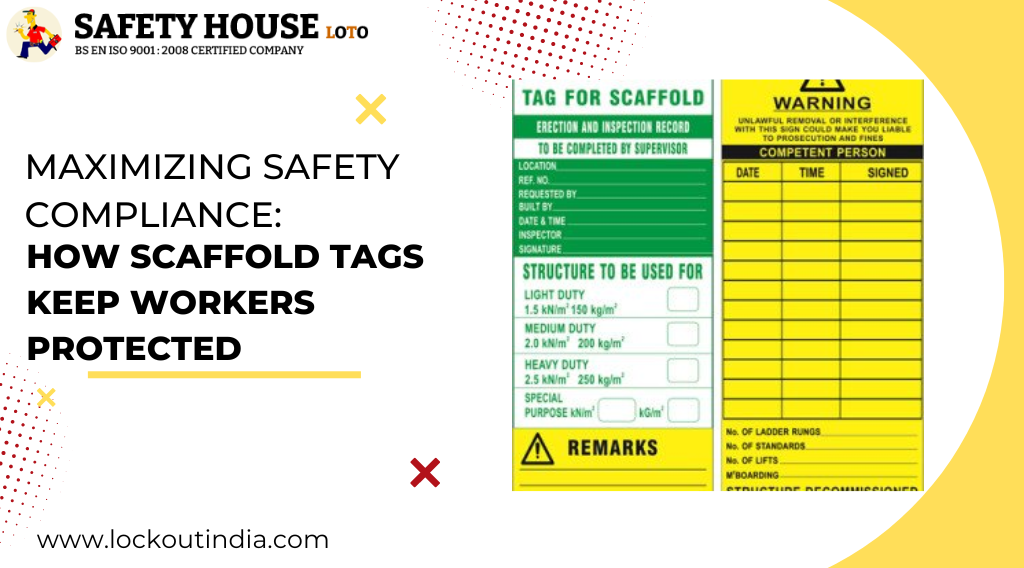
Maximizing Safety Compliance: How Scaffold Tags Keep Workers Protected?
When it comes to working on scaffolds, safety should always be the top priority. However, accidents can still happen despite having strict safety guidelines in place. This is where scaffold tags come into play! These small but powerful tags are essential for maximizing safety compliance and keeping workers protected while working at heights. In this blog post, we’ll delve deeper into what scaffold tags are, how they improve safety measures, their benefits and how to use them effectively to ensure optimal compliance. So grab a cup of coffee and let’s get started!
What Are Scaffold Tags?
Scaffold tags are small identification tags that are attached to scaffolding structures. They contain important information about the scaffold, including its inspection history, weight limitations, safety guidelines and more.
These tags come in various colors, each representing a specific meaning or message. For instance, red may indicate that the scaffold is not safe to use and requires repair work before it can be used again.
In addition to providing essential information about the scaffold structure itself, these tags also play an integral role in enhancing worksite safety measures. They serve as visual reminders of necessary precautions and restrictions that should be followed while working on or around scaffolds.
Furthermore, they help ensure compliance with relevant industry regulations such as OSHA (Occupational Safety and Health Administration) standards for workplace safety.
Scaffold tags are critical components of any scaffolding system and play a vital role in keeping workers safe at all times when working at heights.
How Do Scaffold Tags Improve Safety?
Scaffold tags are an essential tool for improving safety in construction sites that involve scaffolding. They help ensure that workers remain safe while working at heights and prevent accidents from occurring.
One way scaffold tags improve safety is by providing clear instructions to workers about the status of the scaffold. The tag will indicate whether the scaffold has been erected properly, inspected and deemed safe to use or if it’s under repair or maintenance.
Another advantage of using scaffold tags is their ability to communicate important information such as weight limits, maximum height restrictions, and other critical details related to the specific job site. This ensures that workers are aware of all relevant information before they start working on a particular project.
Additionally, Scaffold tags provide visual cues that attract attention and remind workers always to be vigilant when using scaffolding equipment. Workers can easily spot a bright red tag hanging from a scaffold warning them not to use it; this helps prevent accidents from happening due to negligence or oversight.
Using Scaffold Tags improves safety compliance on job sites significantly. By providing clear communication regarding pertinent details about scaffolds’ conditions, weight limits, heights restrictions among others tasks become safer and more efficient for everyone involved in construction projects involving Scaffolds.
What Are The Benefits Of Using Scaffold Tags?
Using scaffold tags on construction sites can bring numerous benefits to workers and employers alike. It allows for easy identification of the current status of a scaffold. This means that every worker who needs to use it will be aware if it is safe to do so or not. Additionally, by using these tags, workers can quickly see when the last inspection was carried out and who performed it.
Another benefit of using scaffold tags is that they help prevent unauthorized access. With a clear “Do Not Use” message displayed on the tag when necessary, only those with proper training and authorization are allowed to work on the scaffolding structure.
Furthermore, having effective safety measures in place like scaffold tags will reduce accidents rates significantly while improving overall safety conditions at work. In turn, this leads to increased productivity since less time is lost due to injuries or non-compliance issues.
Using scaffold tags demonstrates compliance with OSHA regulations which could prevent costly fines and legal battles down the line. By showing an active commitment towards workplace safety through such practices as utilizing lockout tagout products like Scaffolds Tags Scaffolding Tags – companies can avoid potentially expensive penalties while keeping their employees safe from harm.
How To Use Scaffold Tags Effectively?
Using scaffold tags effectively is crucial for ensuring worker safety on construction sites. Here are some tips to help you use them properly:
1. Follow manufacturer instructions: Always read and follow the manufacturer’s instructions carefully when using scaffold tags.
2. Properly attach the tag: Make sure the tag is securely attached to the scaffolding frame or structure in a visible location that can be easily seen by workers.
3. Update information regularly: Keep your scaffold tags up-to-date by updating important information such as inspection dates, load limits, and other relevant details.
4. Use clear language and icons: Use clear, easy-to-understand language and icons on your scaffold tags so that everyone who sees it can understand its meaning.
5. Train workers about proper usage: Ensure all workers are trained on how to correctly use scaffold tags and what each element means before they begin working on a site with scaffolding present.
By following these tips, you can ensure that your team is using scaffold tags effectively, thus minimizing risks of accidents or injuries on construction sites while staying compliant with safety regulations.
Scaffold Tag Compliance Best Practices
To ensure the safety of workers, it is crucial to adhere to scaffold tag compliance best practices. Here are some tips for effective compliance:
Always use durable tags that cannot easily be damaged or removed. The tag should also be clearly visible and capable of withstanding harsh environmental conditions.
Always make sure that the correct information is included on the tag such as date of inspection, load capacity and any other relevant details.
Implement a tagging system where tags are assigned to specific scaffolds and workers. This ensures accountability and makes it easier to identify when a scaffold requires attention.
Fourthly, develop a routine inspection schedule for both internal inspections by staff members as well as external inspections carried out by professionals.
Train your employees on how to read scaffold tags so they can identify if there are any issues with the structure that require attention before proceeding with work activities.
By adhering to these best practices in scaffold tag compliance, you will help keep your workplace safe for all employees who use scaffolding structures while performing their job duties.
Conclusion
Scaffold tags are an essential tool in ensuring worker safety and compliance with industry regulations. By using scaffold tags effectively, workers can easily identify the status of a scaffold and take necessary precautions to avoid accidents.
Remember, when it comes to scaffolding safety, there is no room for shortcuts or complacency. Therefore, always follow best practices for maintaining compliance with lockout tagout products like scaffold tags.
By doing so, you will not only ensure a safe working environment but also demonstrate your commitment to workplace safety and protecting your employees from harm. So let’s make sure that we use these simple yet effective tools wisely in order to maximize our efforts toward workplace safety!
Checkout Our Popular Products:
- Key box
- Valve lockout
- Loto Kit
- Lockout supplier









